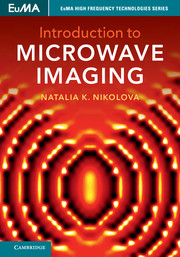Book contents
- Frontmatter
- Dedication
- Epigraph
- Contents
- Preface
- Notation
- Acronyms
- 1 Scalar-Wave Models in Electromagnetic Scattering
- 2 Electromagnetic Scattering: The Vector Model
- 3 Scattering Parameters in Microwave Imaging
- 4 Linear Inversion in Real Space
- 5 Linear Inversion in Fourier Space
- 6 Performance Metrics in Imaging
- 7 Looking Forward: Nonlinear Reconstruction
- Appendix A Maxwell's Equations
- Appendix B Electromagnetic Vector Wave and Helmholtz Equations
- Appendix C Scalarized Electromagnetic Models
- Appendix D Causal, Acausal, and Adjoint Solutions to the Wave Equation
- References
- Index
3 - Scattering Parameters in Microwave Imaging
Published online by Cambridge University Press: 08 July 2017
- Frontmatter
- Dedication
- Epigraph
- Contents
- Preface
- Notation
- Acronyms
- 1 Scalar-Wave Models in Electromagnetic Scattering
- 2 Electromagnetic Scattering: The Vector Model
- 3 Scattering Parameters in Microwave Imaging
- 4 Linear Inversion in Real Space
- 5 Linear Inversion in Fourier Space
- 6 Performance Metrics in Imaging
- 7 Looking Forward: Nonlinear Reconstruction
- Appendix A Maxwell's Equations
- Appendix B Electromagnetic Vector Wave and Helmholtz Equations
- Appendix C Scalarized Electromagnetic Models
- Appendix D Causal, Acausal, and Adjoint Solutions to the Wave Equation
- References
- Index
Summary
The scattering parameters, also known as S-parameters, are the most common network parameters used to describe the performance of the microwave (MW) devices, circuits, and networks in the frequency domain. They are also the measured quantities in frequency-sweep measurements. The most widely used MW test instrument is the vector network analyzer (VNA), which measures accurately and efficiently the Sparameters of N-port networks. The most common VNAs have 2 ports, i.e., N = 2, but VNAs with 3, 4, 8, and even 24 ports are commercially available. Moreover, radiofrequency (RF) switches are available that can increase the number of ports that a VNA can handle.
In MW imaging, the illuminating and receiving antennas together with the measurement setup and the imaged object form a MW network. This is illustrated in Fig. 3.1. If the setup consists of N antennas, the VNA (possibly with an additional RF switch) must have N ports to which the antennas are connected with precision coaxial cables and connectors. The cables and the connectors come in many varieties and have widely varying performance characteristics. Note that using high-quality cables and connectors is critical for a good (repeatable) measurement. It is this network's S-parameters that comprise the data. Since the VNA measures one frequency at a time, we have a subset of S-parameter data at each frequency. At each frequency, one port (one antenna) at a time is excited while all other antennas (marked as Rx in Fig. 3.1) receive. This allows for acquiring the respective transmission S-parameters. The reflection S-parameter at the terminals of the transmitting (Tx) antenna is also acquired. This is repeated for each antenna (each port) in the setup. Thus, at each frequency we have a set of N ×N S-parameters, which form the so-called scattering matrix or S-matrix of the network.
Basics ofS-Parameters
Electrical engineers are familiar with the various parameters used to characterize an N-port (2N-terminal) network such as the Z-parameters (the impedance matrix), the Y -parameters (the admittance matrix), the H-parameters (the hybrid matrix), and the ABCD parameters of 2-ports (the transmission matrix). All of these parameter sets relate the voltages and the currents at the network's ports.
- Type
- Chapter
- Information
- Introduction to Microwave Imaging , pp. 154 - 181Publisher: Cambridge University PressPrint publication year: 2017

